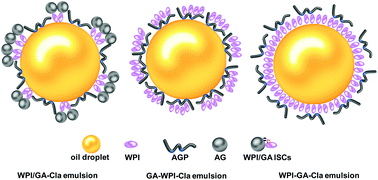Stability and digestibility of one- or bi-layered medium-chain triglyceride emulsions with gum Arabic and whey protein isolates by pancreatic lipase in vitro
Abstract
Interfacial engineering approaches have been used to design functional foods so as to control lipase-induced digestion of emulsified lipids and release of bioactive lipophilic components in the gastrointestinal tract. In this study, emulsion droplets with the interface stabilized with gum Arabic (GA) and whey protein isolate (WPI) were prepared by mixing or sequential adsorption. WPI/GA intramolecular soluble complexes (ISCs) have superior emulsifying properties in stabilizing oil-in-water emulsions. The impact of the interfaces for WPI/GA ISC-layered (one-layered) and double-layered emulsions formed by sequential deposition of WPI or GA on the lipolysis of emulsions was investigated using an in vitro simulated gastrointestinal model. Transglutaminase and dithiothreitol were introduced to crosslink the interfacial proteins and improve the interfacial stability. The ISC-layered emulsion was less stable to aggregation than the double-layered ones in simulated gastric fluid due to dissociation of ISCs caused by the electrostatic screening of ions and proteolysis of interfacial proteins driven by pepsin. The ISC-layered emulsion conferred a significant slower rate and extent of lipid digestion compared to the double-layered emulsions post gastric proteolysis (P < 0.05). It is presumed for the ISC-layered emulsion that the destabilization to aggregation and coalescence within the simulated gastrointestinal fluids and the steric hindrance of the robust and thick interfacial layer might contribute to delaying free fatty acids release. It suggests that both the initial interfacial properties and the stability of the emulsified lipid droplets within the simulated gastrointestinal fluids play an important role in determining the rate and extent of lipid digestion. It is predicted that direct destabilization of emulsified lipids using interfacial engineering approaches has the potential of modifying lipid digestibility or bioactive release at specific sites within the gastrointestinal tract.



 Please wait while we load your content...
Please wait while we load your content...